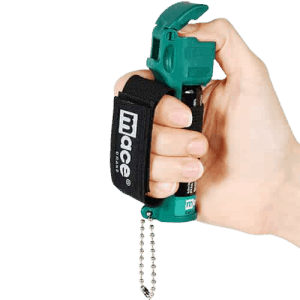Using pepper spray on dogs for self-defense involves deploying a concentrated chili pepper extract called capsaicin, which causes intense irritation in the eyes, nose, and throat. Upon exposure, dogs experience severe eye irritation, sneezing, and increased vocalizations, with symptoms lasting 30-45 minutes. It’s effective due to its quick incapacitating effects and the temporary blindness and disorientation it causes. Proper usage guarantees safety, including holding the canister firmly and monitoring wind direction. Understanding the ethical implications and legal considerations is vital to use it responsibly and humanely. You’ll gain further insights by exploring more detailed guidance.
Key Takeaways
- Pepper spray capsaicin causes intense eye, nose, and throat irritation in dogs, leading to immediate discomfort.
- Dogs exhibit behaviors such as pawing at the face, sneezing, and vocalizing due to the burning sensation.
- The spray can cause temporary blindness and disorientation, making it an effective non-lethal deterrent.
- Symptoms peak within 10-20 minutes and generally subside after 30-45 minutes.
What Is Pepper Spray?
 Pepper spray is a self-defense tool that contains a concentrated extract of chili peppers, designed to incapacitate an attacker. This versatile tool comes in various types, each formulated to suit different self-defense needs.
Pepper spray is a self-defense tool that contains a concentrated extract of chili peppers, designed to incapacitate an attacker. This versatile tool comes in various types, each formulated to suit different self-defense needs.
When considering pepper spray types, you’ll find options such as stream, gel, foam, and fogger. Each type has its own advantages and disadvantages depending on the situation and intended use.
Stream pepper spray, for instance, allows for precise targeting but requires better aim. Gel and foam stick to the target and reduce the risk of blowback, making them ideal for indoor use. Fogger spreads over a wider area, which can be useful in outdoor situations where accuracy might be compromised.
Understanding how dogs react to pepper spray is vital to understanding dog behavior. Dogs have a keen sense of smell and are likely to retreat when exposed to the irritating effects of pepper spray. However, their behavior can be unpredictable, and while pepper spray can temporarily incapacitate an aggressive dog, it’s important to use it judiciously.
Knowing the different pepper spray types helps you choose the best option for effectively managing encounters with dogs.
Capsaicin: The Active Ingredient
Capsaicin, the active ingredient in pepper spray, originates from chili peppers and is responsible for their heat. When used on dogs, it causes temporary irritation in the eyes, nose, and throat, making it an effective deterrent. Understanding its safety and effectiveness is essential for responsible self-defense.
Origin of Capsaicin
 Derived from chili peppers, the compound responsible for their heat is capsaicin. Historically, capsaicin has been used in various cultures for medicinal purposes, culinary applications, and even as a deterrent against pests. Ancient civilizations recognized the intense heat of chili peppers and incorporated them into their diets and traditional remedies. For instance, Indigenous peoples in the Americas used chili peppers not only to enhance flavor but also to treat ailments like sore throats and arthritis.
Derived from chili peppers, the compound responsible for their heat is capsaicin. Historically, capsaicin has been used in various cultures for medicinal purposes, culinary applications, and even as a deterrent against pests. Ancient civilizations recognized the intense heat of chili peppers and incorporated them into their diets and traditional remedies. For instance, Indigenous peoples in the Americas used chili peppers not only to enhance flavor but also to treat ailments like sore throats and arthritis.
Cultural perceptions of capsaicin have evolved remarkably over time. In many cultures, the heat from chili peppers is seen as a desirable trait in cooking, enhancing both flavor and the eating experience. Conversely, the same fiery quality that makes chili peppers a culinary favorite also makes capsaicin an effective self-defense tool. When concentrated, capsaicin can cause intense irritation, which is why it’s a key ingredient in pepper spray.
Understanding the origin and historical uses of capsaicin helps you appreciate its dual role as both a culinary ingredient and a defensive mechanism. This knowledge underscores why capsaicin, derived from chili peppers, is so effective in various applications, especially in self-defense products like pepper spray.
Impact on Dogs
When pepper spray is used on dogs, the capsaicin causes immediate discomfort and irritation, effectively discouraging further aggression. Capsaicin, derived from chili peppers, targets the sensitive mucous membranes in a dog’s eyes, nose, and throat. This leads to intense burning sensations and inflammation, causing the dog to retreat or halt its aggressive behavior.
Understanding dog behavior is essential for employing self-defense tactics. When a dog exhibits aggression, it could be out of fear, territoriality, or protection. Pepper spray offers a non-lethal method to manage these situations, allowing you to create a safe distance between yourself and the dog. The immediate impact of capsaicin disrupts the dog’s focus, making it less likely to continue its threatening actions.
It’s important to note that pepper spray doesn’t cause permanent harm to dogs. While the effects are intense, they are temporary and typically subside within 30 to 45 minutes. This makes it a humane option for self-defense, ensuring that you can protect yourself without inflicting long-term damage on the animal.
Safety and Effectiveness
 Understanding how capsaicin works can help you gauge the safety and effectiveness of pepper spray for self-defense against dogs. Capsaicin, the active ingredient in pepper spray, is derived from chili peppers. It causes an intense burning sensation when it comes into contact with mucous membranes. This reaction can temporarily incapacitate a dog, giving you time to remove yourself from a potentially dangerous situation.
Understanding how capsaicin works can help you gauge the safety and effectiveness of pepper spray for self-defense against dogs. Capsaicin, the active ingredient in pepper spray, is derived from chili peppers. It causes an intense burning sensation when it comes into contact with mucous membranes. This reaction can temporarily incapacitate a dog, giving you time to remove yourself from a potentially dangerous situation.
In terms of dog behavior, capsaicin affects dogs similarly to how it affects humans. The burning sensation in the eyes, nose, and throat can lead to temporary blindness, difficulty breathing, and disorientation. These effects can be particularly beneficial in self-defense scenarios, as they provide a non-lethal means of deterring an aggressive dog. However, using pepper spray responsibly and only as a last resort is essential.
Incorporating pepper spray into your self-defense training can be effective, but you should also know the potential risks. Misuse or overuse can lead to unnecessary suffering for the animal and potential legal consequences for you. Always aim to understand both the benefits and limitations of capsaicin-based sprays to guarantee they’re used safely and effectively.
Effects on Canine Physiology
When pepper spray is used on dogs, it primarily affects their respiratory system and eyes. The inflammation of the airways causes difficulty breathing, coughing, and choking. Additionally, it leads to severe ocular irritation, resulting in intense tearing, pain, and temporary blindness.
Respiratory System Impact
Pepper spray can cause severe irritation in a dog’s respiratory system, leading to coughing, choking, and difficulty breathing. When a dog inhales the chemicals in pepper spray, it experiences an immediate inflammatory response in its respiratory tract. This reaction can result in significant respiratory distress, characterized by rapid, shallow breathing and an increased panting rate. The inflammatory response causes the mucous membranes lining the nasal passages, throat, and lungs to swell, further exacerbating the dog’s difficulty in drawing breath.
 In addition to the physical discomfort, the dog might also experience a burning sensation in its airways, leading to persistent coughing and gagging. As the airways become inflamed, they produce excess mucus, which might cause the dog to choke or even vomit. This combination of symptoms can be particularly distressing for the animal and may lead to panic, which only worsens its breathing difficulties.
In addition to the physical discomfort, the dog might also experience a burning sensation in its airways, leading to persistent coughing and gagging. As the airways become inflamed, they produce excess mucus, which might cause the dog to choke or even vomit. This combination of symptoms can be particularly distressing for the animal and may lead to panic, which only worsens its breathing difficulties.
It’s essential to understand that while pepper spray is effective for self-defense, its impact on a dog’s respiratory system can be severe and immediate. Proper use and awareness of these effects can help guarantee that the tool is used responsibly and only when absolutely necessary.
Ocular Irritation Effects
Exposure to pepper spray can cause intense ocular irritation in dogs, resulting in redness, swelling, and profuse tearing. When the spray comes into contact with a dog’s eyes, it activates pain receptors and leads to immediate discomfort. The capsaicin in pepper spray inflames the mucous membranes, causing the eyes to produce excessive tears in an attempt to flush out the irritant.
This reaction can lead to temporary vision impairment, making it difficult for the dog to navigate or continue any aggressive behavior. In severe cases, if the exposure is prolonged or if the dog repeatedly rubs its eyes, there’s a risk of ocular damage. This could include corneal abrasions or even more severe injuries that might require veterinary attention.
While most effects are temporary, long-term effects may occur if the exposure is significant or if the dog has a preexisting condition that exacerbates the reaction. Symptoms like chronic dry eye or recurring infections could develop.
It’s essential to monitor the dog for any signs of persistent distress and seek professional help if necessary. Proper preventive measures should always be considered to avoid unnecessary harm to animals.
Immediate Symptoms in Dogs
Upon contact, dogs will typically exhibit immediate symptoms such as intense eye irritation and excessive drooling. These reactions occur because pepper spray contains capsaicin, which irritates mucous membranes.
When a dog is sprayed, you might observe:
- Violent pawing at the face: Dogs will try to alleviate the burning sensation by rubbing their faces with their paws.
- Continuous sneezing: The irritation can cause a reflexive sneezing response as the dog attempts to clear its nasal passages.
Understanding these behavioral responses is vital if you consider pepper spray for self-defense. While pepper spray can temporarily incapacitate a threatening dog, it’s also essential to explore training alternatives. These methods can teach dogs to avoid aggressive behaviors, reducing the need for such defensive measures.
It’s important to note that the severity of symptoms can vary based on the dog’s size, health, and the amount of spray used. Always aim to use the minimal effective amount and consider the ethical implications and potential harm to the animal.
Duration of Effects
While the immediate symptoms are distressing, you should know that the effects of pepper spray on dogs typically last from 30 to 45 minutes. During this time, the dog will experience intense discomfort, including burning sensations in the eyes, nose, and throat. However, the duration comparison shows that the effects on dogs are generally shorter than those on humans, who may experience discomfort for up to an hour.
Here’s a quick overview of the duration and recovery time:
| Effect Duration | Dogs | Humans |
|---|---|---|
| Immediate Effects | 0-2 minutes | 0-2 minutes |
| Peak Discomfort | 10-20 minutes | 15-30 minutes |
| Total Duration | 30-45 minutes | 45-60 minutes |
Recovery time for dogs can vary based on the amount of spray used and the dog’s size and health. Most dogs start to recover within 45 minutes, showing signs of relief such as reduced pawing at their faces and less drooling. While the symptoms are severe initially, they don’t cause permanent harm if used correctly.
Understanding the duration comparison and recovery time helps you gauge when the dog might return to normal behavior, ensuring you can manage the situation effectively. These effects are temporary, and the dog will gradually recover within the specified timeline.
Proper Usage Techniques
 To use pepper spray effectively for self-defense against dogs, you must follow specific techniques to guarantee safety and efficacy.
To use pepper spray effectively for self-defense against dogs, you must follow specific techniques to guarantee safety and efficacy.
First, ensure you’ve undergone self-defense training to familiarize yourself with the spray’s operation. When a dog approaches aggressively, maintain a calm demeanor and aim for the dog’s face, specifically targeting the eyes, nose, and mouth for maximum impact. This will temporarily incapacitate the dog, giving you time to retreat to a safe location.
- Hold the canister firmly: Grip it securely to prevent it from slipping, guaranteeing a steady aim.
- Spray in short bursts: A quick, controlled burst is more effective than a prolonged spray and conserves the contents for multiple uses.
Responsible ownership also means understanding the limitations and proper usage of pepper spray, ensuring it’s used only when absolutely necessary.
Regularly practice these techniques to build muscle memory to prepare you if an aggressive dog confronts you.
Safety Precautions
When using pepper spray for self-defense against dogs, always prioritize your safety and the safety of those around you. First, verify you’re familiar with the pepper spray’s operation. Practice using it in a controlled environment so you’re prepared in an emergency. Aim for the dog’s face, particularly the eyes and nose, for maximum effectiveness without causing unnecessary harm.
Here’s a quick reference table to help you keep safety at the top of your mind:
| Safety Precaution | Why It’s Important | Additional Tips |
|---|---|---|
| Understand the Spray’s Range | Prevents accidental exposure to bystanders | Test spray outdoors |
| Monitor Wind Direction | Avoids blowback on yourself | Spray downwind |
| Store Properly | Prevents accidental discharge or damage | Keep in a cool, dry place |
| Consider Dog Training | Reduces the need for pepper spray | Invest in professional training |
Additionally, always carry the spray where it’s easily accessible. In high-risk areas, consider humane alternatives like ultrasonic devices that can deter dogs without physical harm. Regularly check the expiration date of your pepper spray to verify it’s effective when needed. By following these safety precautions, you can responsibly use pepper spray while minimizing risks and exploring other non-violent measures.
Legal Considerations
 Before using pepper spray for self-defense against dogs, it’s important to understand the legal considerations in your area. Legal regulations and self-defense laws vary greatly depending on your location. In some places, using pepper spray on animals is strictly regulated, while in others, it might be more lenient. Not knowing these laws could lead to unexpected legal consequences.
Before using pepper spray for self-defense against dogs, it’s important to understand the legal considerations in your area. Legal regulations and self-defense laws vary greatly depending on your location. In some places, using pepper spray on animals is strictly regulated, while in others, it might be more lenient. Not knowing these laws could lead to unexpected legal consequences.
First, local ordinances and state laws should be checked to determine if pepper spray is permitted for animal use. Some areas might classify it strictly for use against human attackers. Additionally, it’s prudent to review any restrictions on the type and strength of pepper spray you can carry.
Consider these factors:
- Local ordinances: Specific rules or bans in your town or city.
- State regulations: Broader laws that might have more detailed stipulations.
Understanding these legal frameworks guarantees that you will protect yourself and stay within the law. Always consult with local law enforcement or legal experts to get the most accurate and detailed advice for your situation.
Ethical Implications
Considering the ethical implications of using pepper spray on dogs for self-defense involves weighing the well-being of the animal against your need for protection. Ethical dilemmas arise because, while your safety is paramount, causing harm to an animal raises significant concerns about animal welfare. Dogs, often seen as companions, deserve humane treatment, even in defense situations.
When faced with an aggressive dog, using pepper spray might seem necessary. However, you must consider if there are fewer harmful alternatives. Training in dog behavior, using deterrent devices like ultrasonic repellers, or carrying a sturdy walking stick for self-defense might offer more ethical choices.
Moreover, understand the impact of pepper spray on a dog. The spray causes intense pain, temporary blindness, and respiratory distress, which are severe reactions for an animal. Weighing these consequences against the potential threat requires a balanced assessment of both the immediate danger to you and the long-term effects on the animal.
Ultimately, making an informed decision involves understanding the severity of the threat and your ethical responsibilities towards the animal. Prioritize your safety, but also consider the broader implications of your actions on animal welfare.



